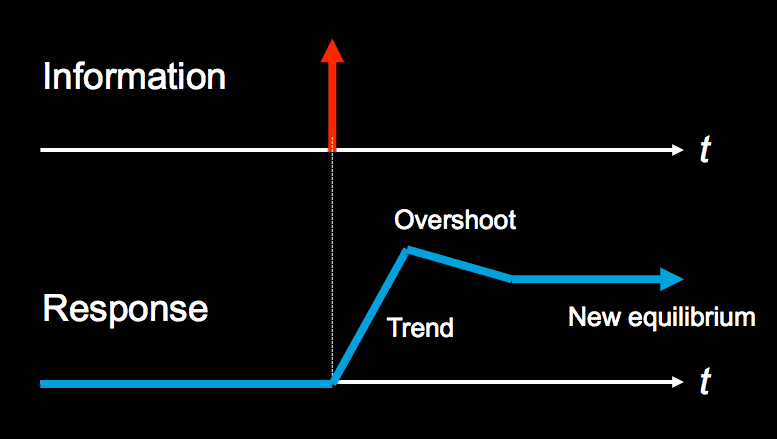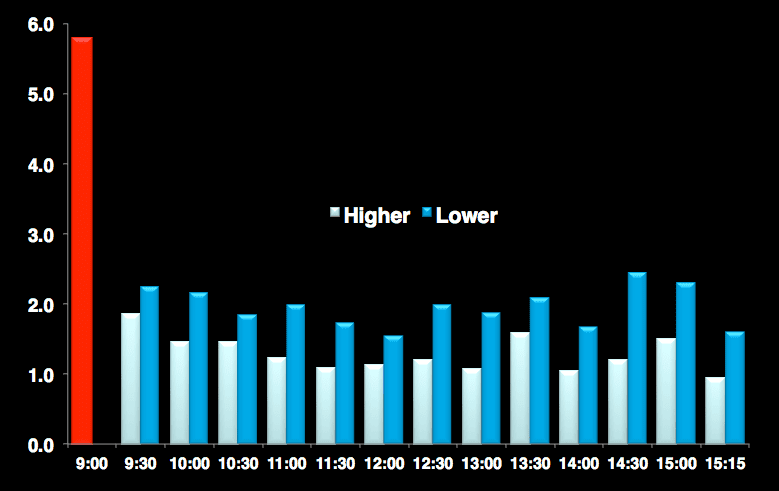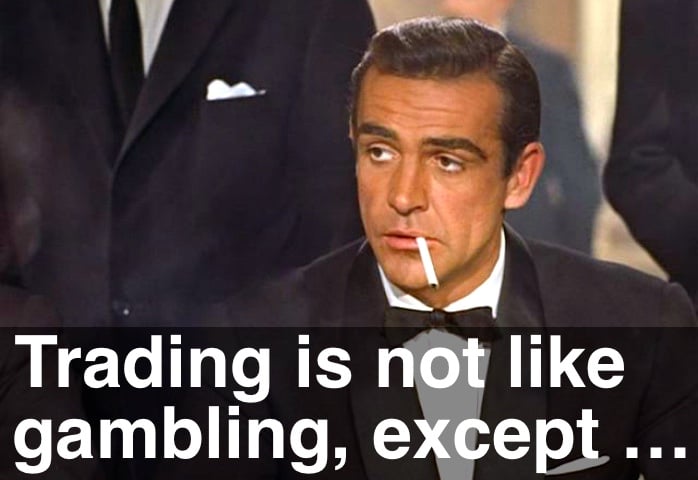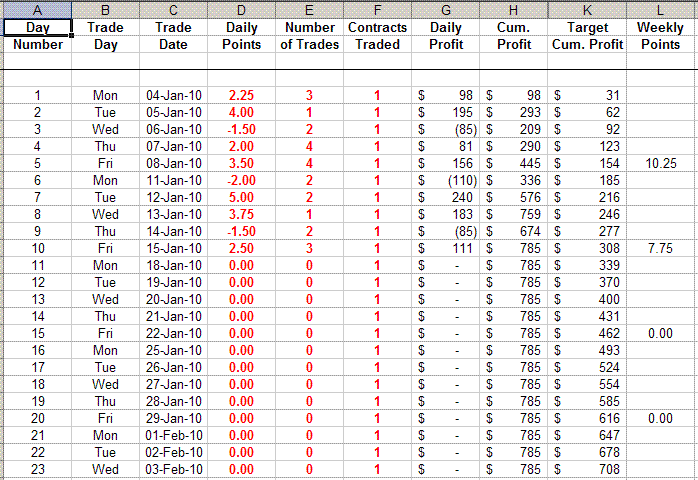Transcript of the video
It is Sunday, 25th of January 2015, and I hope you’re having a great weekend. So, something a little bit different in this weekend’s video. I want to talk about “Day Trading Is Not Like Gambling, Except for This”. And it’s a little bit of a follow-up to a video I put out – it’s quite some time ago now – called “Is Trading Gambling?” in which I argued that day trading was nothing like gambling. And it actually became one of the two most commented on videos on the website since the beginning of the website.
Of course, everybody, all the day traders out there, the visitors and followers of Emini-Watch came out categorically in favor, saying “Day trading is nothing like gambling”. Well, this week I got a response from one of the questionnaires that is up on the website asking you about what you trade, how you trade, are you profitable and so on. And it prompted me to rethink this whole aspect of trading and gambling. And I think there is one aspect of day trading that is actually a little bit like gambling and so I just want to explore that in this video.
At an young age my father was very successful (and rich)

As a little bit of an intro to this – as a back story to this whole idea of gambling – and it’s taken from my own personal memories as a kid. These are two very old photographs of my parents. That’s my father. I think that was taken in the mid-’50s. And that’s my mother, taken probably in the mid-’60s. She looks a little bit like Lady Di in that photograph. In real life, she does not look like Lady Di. Or didn’t look like Lady Di. If anything, she looks a little bit more like Queen Elizabeth II. But anyway, my father died when I was a teenager. We didn’t get on, but that’s not unusual. He was a very tough man, an extremely successful businessman in his younger years. And so the story goes like this.
He came out of the Second World War and went to university at Georgetown in Washington, D.C. And coming out of university, he went into the mutual fund industry right when the mutual fund industry was starting to take off. So this was a stock market boom that happened during the ’50s and mutual funds were being launched and he got in absolutely on the ground floor, traveled around the world a number of times selling mutual funds to American servicemen who were stationed in U.S. bases around the world after the Second World War.
He became extremely rich from trailing commissions and then he started advising people on how to start mutual funds around the world in places like Toronto, Mexico City, Tokyo, Hong Kong, Geneva and so on. So he was an extremely well-traveled man and a very rich man at a very young age. Now, as things often turn out, that didn’t last and things did turn down. But there was a time when my mother and father would go out to casinos on a fairly regular basis.
My parents had very different personalities
My father would give my mother a certain amount of money and she would go off and do her own thing in the casino. My father would take an equal amount of money – he probably took a little bit more money out of the family kitty – and go off and gamble. My father, after a couple of hours of gambling, would pretty much have been up and down and up and down and then eventually have lost everything that he decided that he was going to gamble with that night.
My mother, by contrast, would have not only won back what my father had lost, she would also win back the entrance fee to get into the casino and then had stopped gambling and would walk away from the tables until my father was done. And then they’d walk away from the casino, my father obviously with his tail between his legs a little bit, but my mother quite happy that they had enjoyed themselves and not come away with any losses.
My mother is a very smart woman. She was an actuary in an insurance company. Actuaries calculate the probabilities of all kinds of things for insurance companies, so she was very mathematically capable. But there was a difference in their personalities. Although my father was an extremely successful businessman, when it came to casinos and gambling, he became reckless. My mother was a very stable, calm, focused person who knew that the casino was a game and you played the game to win a little bit and then you stopped.
The longer you play, the more likely it is you will lose
And it comes down to this. It’s a fairly common phrase that people know about casinos: “The longer you play, the more likely it is you will lose”. The house knows this. They design casinos to keep you in there as long as possible. There are no exterior windows on casinos. You don’t know whether it’s day or night outside. They pump the casino full of oxygen to keep you awake so you don’t feel tired and want to go off to your hotel room or whatever. They also make it attractive to stay there to eat, to drink and so on. The longer you play, the more likely it is you’ll lose. And day trading is just like that.
We all have these two sides of us, this kind of yin and yang. And one is a reckless side to us, an ambitious side, an overly aggressive side. And then the other side to us is the disciplined side, the focused side. We have both of these characteristics in us and at sometimes they’re more dominant than others. Trading can be a very emotional thing and it can bring out the worst of you.
The particular response that I got to one of these questionnaires that I have on the site this week had this quote in it. Now, I’m asking people about whether they’re profitable, what trading methodology they use and so on. It’s an anonymous questionnaire. I’m just curious as to how people are doing as traders and why they’re on the website, why they’re following the website and so on. And a part of the response I got back from this particular visitor was this:
I feel like I am starting to turn towards positive trading for the first time in four years, but I still overtrade. It is not uncommon for me to take over 100 trades in a 24-hour period! (I know)
So someone’s telling us that they know that’s overtrading. Over 100 trades in a 24-hour period is … I mean, we’ve all overtraded. That, I think, is out there in terms of the scale. I remember doing maybe 14 to 16 trades in a day session over the course of two, maybe three, hours. Now overtrading, I think, is going above five or six trades in a 45-minute period. But 100 trades in 24 hours is certainly out there.
That’s the aspect of gambling that I think can be very likened to day trading. The more you day trade, especially during a 24-hour period of time, the more likely it is you’re going to lose. And there’s a reason for that and this is the reason.
The Efficient Market Hypothesis is simply wrong

This is a little bit of Information Theory. Just ignore the title of this little diagram to start with, let’s just talk about these two timelines. The first one is just time is running along at the bottom. It’s just like your chart is coming along and then some news event comes out, some information is released to the marketplace. Bang and it’s a surge of information. It’s a piece of information that becomes available. It’s then known by the market. Time rolls on.
This is the response transformation, what happens to the marketplace. So, we’re in some form of equilibrium here at this point until that information is released. And then when that information is released into the marketplace, a couple of things happen. First of all, not everybody knows straightaway. There’s a delay. There are people that are watching news feeds, Bloomberg feeds, Reuters feeds and so on, that get the jump on the news, pretty instantaneously. But then it’ll take a little bit of time to roll out to the marketplace. That can be a matter of minutes or maybe half an hour or something like that. People who are swing trading, who have day jobs might not know that piece of news until the end of the trading day the next morning, where they’re checking what’s going on.
So there’s an information blip that happens and there’s the response from the market. That response to the market is not instantaneous. It’s not a straight vertical up. There is a little bit of time taken for that information to be digested into the marketplace and for the market to respond. Usually there’s a little bit of overshoot, where the market overshoots in a particular direction. And then over a shorter period of time, we come down to this new equilibrium. So the market then reflects this new information. It’s out in the marketplace and the equilibrium in the market is changed from this old level to this new level.
Now, this is the trending period over a period of time. This is where we make money and this is why the Efficient Market Hypothesis (EMH) is wrong. The Efficient Market Hypothesis says that all information is instantaneously available to all traders in the marketplace and no one can take any advantage of that information in the long term. So that information is efficiently transmitted around the marketplace. And it would assume that we get a transformation response that is just directly up and then reaches this new equilibrium level and stops and that’s why the market is efficient.
Well, that’s not the case. The market is not efficient. The market takes time to respond and this is what we’re trading. This is the trend move. As soon as the market reaches equilibrium, that’s danger, danger, danger. If the market is not moving at all, we can’t make money as day traders. We make money on this information inefficiency in the marketplace, where it takes time for the market to respond to a news event, the opening, whatever it might be.
The first 30 minutes is the best time to trade

But I wondered if I could prove it to you and so I went back and analyzed the last three years’ Emini data in 30-minute increments for each trading day on average. So, let me explain this chart to you. On the vertical axis we have points, Emini points. And then on the horizontal axis, what we have is the day session broken down into 30-minute increments starting at 8:30 in the morning. So this first increment ends at 9:00 in the morning. Then we go 9:30, 10:00 and so on. The last 15 minutes of the day – obviously, this is a 15-minute increment from 3:00 to 3:15, when the markets close and the Emini market is closing.
And then what I wanted to measure was the range during those 30-minute increments, to understand what was the average range, high to low, for the first 30 minutes of trade. And then if the Emini kept on breaking up higher, above the high of that first 30 minutes, how far it went in the next 30-minute increment, 30 minutes after that and so on.
So, what you find is, on average, the Emini trades just under 6 points of range, top to bottom, during the first 30 minutes of trade. Then for the next 30 minutes of trade, if the market is going higher, on the average it goes higher by 2 points. If the market is going lower during that next 30 minutes, it goes lower by just over 2 points. Let’s say 2.2 points on the downside. And then if it keeps on going higher still, the market in the next 30 minutes up until 10 in the morning goes higher by about 1.5 points. If it’s going lower, it goes lower by about 2.1 points and so on. So this is the marginal breaks higher or lower of the Emini during the day.
The first thing to note is that the first 30 minutes is the most volatile of the session. We have the largest range during the first 30 minutes of trade. The second thing to note is that when we break to the downside, the moves are larger – so the downside break bars are all higher than the upside break bars. And this is during the last three years, in which we’ve been in a bull market, so even when we have down days, the volatility is higher on the downside. And I think that’s one of the reasons why I like going short, is because the moves on the downside tend to be faster and more extreme.
Day trading opportunities diminish as the day goes on
But this is what you must focus on. The information comes out at the beginning of the day – 7:30, 8:30 a.m. Chicago time is when the news releases come out. As soon as the open is made and we start to see the direction of the market is starting to move, that’s new information that comes into the marketplace and the whole market reacts to that. Are we going to have an up day, a down day and so on. But as soon as all that information comes out in the first hour or hour and a half of trade, the opportunities for day trading diminish.
The longer you stay in the market trading this backwards and forwards stuff, where we don’t have a great deal of range, that is when you get yourself in trouble. If you like, that’s what the house knows, the casino knows. The longer they keep you at the table, the more you’re going to gamble, the more the odds are in their favor. You can get lucky, you have a little bit of a lucky break, but they know in the long, long term if you keep trading, the odds will come back down to their equilibrium.
And the same is true in the marketplace. As soon as that information has been digested and we’ve made our trend move, we’ve had our little overshoot and we’ve moved that down to a new equilibrium, we get this situation where the range is just compressed dramatically and we just don’t have the opportunities to trade. So you shouldn’t be trying to get onboard little trending moves. You’re not going to find a 4-point trending move at lunchtime in the Emini, because, on average, they just aren’t there. But they definitely are there during the first 30 minutes of trade.
Stop overtrading and acting like a compulsive gambler
So, the takeaway is this: stop overtrading. And I have been guilty of this in the past. But it’s one of the easiest things to fix and it’s one of the things that’ll make the most difference to your bottom line. Stop overtrading.
Pick a small daily profit target, or a reasonable daily profit target, and once you reach that just stop trading. If you can do that it will dramatically increase your chances of being successful at day trading. You don’t want to be messing around trading all day, because the longer the trading day goes, the less trending opportunities there are and the more the market is in equilibrium and you’ll just get chopped around.
So for me, the ideal is 4 Emini points. That’s my profit target on a trade. It’s what my daily profit target is. If I can hit that in one trade in the first 30 minutes of trade, bingo, that’s great. You know, if the market is then still moving quickly and we still have fast moves and so on, jump back in. Pick up another point or two. If you’re lucky, pick up another four. But as soon as you’ve made that small, reasonable daily profit, just stop trading.
We’re all part yin, part yang and it’s like having the devil on one shoulder and an angel on the other shoulder. There are things that we need to do, rules that we need to put in place in order to stop the bad behaviours. Stop the devil talking in our ear and persuading us to trade and trade and keep trading.
Check out the second most controversial video on the website below.
Is Trading Gambling?
I’m a speculator and I’m proud. But it turns out, not everyone likes speculators. I had no idea, until an intimate dinner party on one fateful Friday night.
And the Emini-Watch followers respond to ‘Is Trading Gambling?’
Well, that got the Emini-Watch followers riled up! I received over 50 emails with comments. Wow – biggest response ever to an Emini-Watch anything. Not unsurprisingly the comments were overwhelmingly “trading is good”. Only 2 nay-sayers.
But the other inescapable observation was the clarity and quality of argument. I am so proud and humbled to have amassed a collection of followers who are truly intelligent, articulate, talented and true observers of the market and society. It’s scary too – can’t get anything dodgy past you guys 🙂
Here’s a small sample of the responses:
Trading is NOT gambling. Gambling implies some sort of reckless, irresponsible, ‘let’s-see-what-happens’ behaviour. In fact, trading is the opposite of gambling because trading is a highly disciplined activity that requires strategy and (most importantly) an EDGE. Without an edge, a strategy to employ that edge, and strict discipline to work the strategy, you will fail. So in fact, trading bears very little resemblance to gambling and any trader who gambles will lose, period.
Mike
Trading is gambling. Everything is gambling. When you get out of bed in the morning to go out and make a living, you immediately increase your chance of getting killed. Farmers gamble with the weather. Apple gambles on a new electronic product’s acceptance. Hollywood gambles on every movie it makes. The only reason you think gambling is bad is that the people at the top use that meme to keep you in your place.
Mike T.
I work in a casino in Vegas and I can tell you that trading is NOT gambling! Gambling is essentially taking on risk while leaving things to chance. If you have an edge, then in the long run you are going to win, even though you might lose in the short term. The casinos are risking money by offering blackjack, slots and others, but since the odds are in their favor they come out ahead. They consider it a profitable business, much like trading can be and is for many people.
Aaron B.
In socialist Norway, I gain more from saying I am an investor rather than a trader, or god forbid a speculator. People generally treat me better.
Karl L.
Years ago when I managed our family farm, same family 175 years in central Illinois, I learned about commodity markets. I was grateful for the corn and soybean markets that allowed me to sell what we produced at the time of year and price level that was my choice, not someone else’s choice. Sometimes I sold before harvest, sometimes after. The liquid markets for corn and beans allowed me to take responsibility for this important aspect of being a producer.
Without speculators creating liquidity my only option would have been Archer’s Daniels Midland, at harvest time. And we’d have been allowed to make just enough to plant the next years crop and pay our taxes – just enough to squeeze a living from the land. Because of broad speculation in corn and soybeans ADM’s influence was mitigated and more profit was available to us farmers.
To me the zero sum game aspect of trading says ‘balance’ – which is something good. This fractal nature of this constant re-balancing is a beautiful thing. The only thing that messes it up is the kind of thinking that advocates for things like public funded bailouts of private entities, and pseudo private entities like Fannie Mae and Freddie Mac.
Jeff W.
If somebody has problem with (trading) they can kiss my capitalist ass. Thank for your contributions to the trading community.
John N.
People think playing games with real estate is fine. Buying and selling art is fine. Buying diamonds from a monopoly is fine. But shares and bonds and all the financial products are the domain of the rascals. We’re merrily heading in the wrong direction, so better enjoy the ride.
Erico T.
Is trading ‘immoral’? It’s kind of like two cage fighters, both are willing combatants!
Rohan P.
Trading is, at its core, ammoral, meaning neither good nor bad. It just is. There are many jobs that can be viewed as ammoral, neither good nor bad, not making the world a better place but simply a means to an end.
The question of morality comes into play when individually we make a decision on what to do with our money, our time and our talents. Are we using the money that we make, the time that we have and the talents that we possess to make the world a better place. Without the ammoral job of trading I wouldn’t have the funds necessary to do what I want to do which is make a difference in this world.
Aaron Y.
What Shorting, Nighttime and Winter all have in common is they are all parts of the yin and yang, the cyclical duality of the world. There can’t be one without the other.
Mark B.
And this beauty, which sums up the ‘control your life’ angle:
At the end of the day, I find these types of arguments tiresome. What are day traders trying to accomplish? We are trying to build a better life for ourselves, one that allows true financial freedom.
The entire economic system is set up to force you to work your entire life away, from 18 to 65 yo – the prime of life – in the hopes of MAYBE being able to retire someday with a pittance of a pension. IF you’re lucky. Everything in this system – from the salary you make, to every single tax you pay, to the price of all goods and services, EVERYTHING is geared for one thing and one thing only: to keep you working.
They pay you a decent wage, but not too much that you can retire early and they tax you as much as they can get away with, but not tooooo much that you can’t afford to buy anything – all so that you keep juuuuust enough to keep going and keep working. I don’t begrudge the need to be productive, of course, but I do not buy into this mindset that we have to work our entire lives away and never aspire to break out of this trap.
I want to achieve a better life. This is the possibility that day trading offers … to take total and complete control of our finances. What is wrong with that?? We don’t want to trust brokers or bankers or Ben Bubblehead Bernanke with our money – we want to assume total responsibility for it. That’s not immoral, that’s taking initiative and looking after oneself. This is a good thing.
Mike
What Shorting, Nighttime and Winter all have in common is they are all parts of the yin and yang, the cyclical duality of the world. There can’t be one without the other.
Mark B.
Plus, courtesy of Michael S., the classic German bund trader video:




